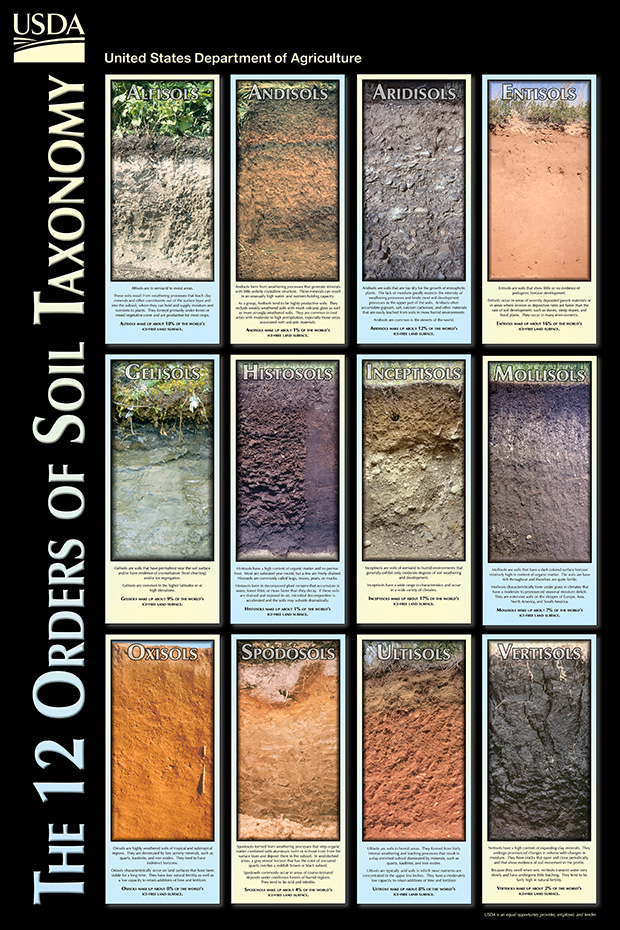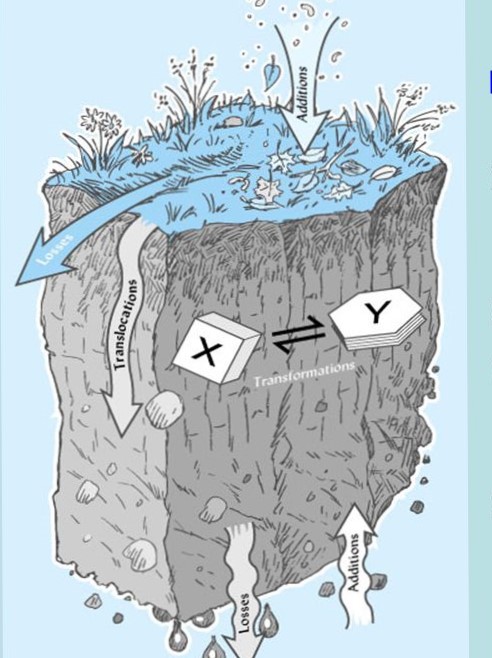Soil processes: Difference between revisions
No edit summary |
No edit summary |
||
| Line 5: | Line 5: | ||
[[File:Nrcs.jpg]] | [[File:Nrcs.jpg]] | ||
Image 1: 12 soil groups: (Natural Resources Conservation Service.” The Twelve Orders of Soil Taxonomy ) | |||
---- | ---- | ||
| Line 11: | Line 11: | ||
'''Soil Processes''' can be characterized into four groups: | '''Soil Processes''' can be characterized into four groups: | ||
[[File:Four+basic+processes+of+soil+formation .jpg]] | |||
Image 2: Four groups of soil processes (Fairman, Patrick) | |||
'''1: Additions:''' Adding material to the soil helps build soil horizons. Materials can be made up of detritus (organic material), atmospheric dust, or soluble salts from groundwater (Krzic M.). | '''1: Additions:''' Adding material to the soil helps build soil horizons. Materials can be made up of detritus (organic material), atmospheric dust, or soluble salts from groundwater (Krzic M.). | ||
'''2:Translocations:''' Transportation of materials (organic or inorganic) between soil horizon layers either up or down. Primararly water driven however on a small scale, fauna have great influence. | '''2: Translocations:''' Transportation of materials (organic or inorganic) between soil horizon layers either up or down. Primararly water driven however on a small scale, fauna have great influence. | ||
''pedoturbation''is the term for mixing of soils. | ''pedoturbation''is the term for mixing of soils. | ||
| Line 23: | Line 26: | ||
Algillic pedoturbation occurs with the mixing of clays through churning processes called sink-swell cycles. These cycles are dominated by moisture and when dry, clays will crack allowing for lower horizons to be exposed to new materials (K-State Research and Extension.) | Algillic pedoturbation occurs with the mixing of clays through churning processes called sink-swell cycles. These cycles are dominated by moisture and when dry, clays will crack allowing for lower horizons to be exposed to new materials (K-State Research and Extension.) | ||
'''Transformations:''' | '''3: Transformations:''' Transferring soil constituents from one form to another. Ex: Mineral weathering and organic matter breakdown. | ||
Revision as of 18:23, 16 April 2018
Soil Processes
Soil processes are specific changes to a soil influencing the relationship between soil and its ecosystem, landscape, flora, and fauna (Krzic M.). One key component to soil processes is the formation of soil. The formation of soil can be condensed into four major components as outlined in the Jenny Equation: Climate (temperature, moisture), biological factors (organisms), Topography (relief/slope), parent material (origin of soil particles), and Time. Based off the formation processes and the different horizons of soil layers, a soil sample may be classified into 12 soil orders according to a Soil taxonomy (Natural Resources Conservation Service).
 Image 1: 12 soil groups: (Natural Resources Conservation Service.” The Twelve Orders of Soil Taxonomy )
Image 1: 12 soil groups: (Natural Resources Conservation Service.” The Twelve Orders of Soil Taxonomy )
Soil Processes can be characterized into four groups:
 Image 2: Four groups of soil processes (Fairman, Patrick)
Image 2: Four groups of soil processes (Fairman, Patrick)
1: Additions: Adding material to the soil helps build soil horizons. Materials can be made up of detritus (organic material), atmospheric dust, or soluble salts from groundwater (Krzic M.). 2: Translocations: Transportation of materials (organic or inorganic) between soil horizon layers either up or down. Primararly water driven however on a small scale, fauna have great influence.
pedoturbationis the term for mixing of soils.
Fauna translocators examples: Earthworms, Ants, moles, rodents.
Flora translocators occur when blowdown trees uproot. The root ball exposes new soil horizons to the surface and provide opportunity for seeds to germinate. Eventually this blown down tree will create pit and mound features in a forest (Krzic M.)
Algillic pedoturbation occurs with the mixing of clays through churning processes called sink-swell cycles. These cycles are dominated by moisture and when dry, clays will crack allowing for lower horizons to be exposed to new materials (K-State Research and Extension.)
3: Transformations: Transferring soil constituents from one form to another. Ex: Mineral weathering and organic matter breakdown.